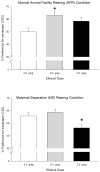Early maternal separation affects ethanol-induced conditioning in a nor-BNI insensitive manner, but does not alter ethanol-induced locomotor activity
- PMID: 22108648
- PMCID: PMC3256748
- DOI: 10.1016/j.pbb.2011.11.005
Early maternal separation affects ethanol-induced conditioning in a nor-BNI insensitive manner, but does not alter ethanol-induced locomotor activity
Abstract
Early environmental stress significantly affects the development of offspring. This stress has been modeled in rats through the maternal separation (MS) paradigm, which alters the functioning of the HPA axis and can enhance ethanol intake at adulthood. Infant rats are sensitive to ethanol's reinforcing effects, which modulate ethanol seeking and intake. Little is known about the impact of MS on sensitivity to ethanol's appetitive and aversive effects during infancy. The present study assessed ethanol-induced conditioned place preference established through second-order conditioning (SOC), spontaneous or ethanol-induced locomotor activity and ethanol intake in preweanling rats that experienced normal animal facility rearing (AFR) or daily episodes of maternal separation (MS) during postnatal days 1-13 (PDs 1-13). Low-ethanol dose (0.5 g/kg) induced appetitive conditioned place preference (via SOC) in control rats given conventional rearing but not in rats given maternal separation in early infancy, whereas 2.0 g/kg ethanol induced aversive conditioned place preference in the former but not the latter. The administration of a kappa antagonist at PD 1 or immediately before testing did not alter ethanol-induced reinforcement. High (i.e., 2.5 and 2.0 g/kg) but not low (i.e., 0.5 g/kg) ethanol dose induced reliable motor stimulation, which was independent of early maternal separation. Ethanol intake and blood alcohol levels during conditioning were unaffected by rearing conditions. Pups given early maternal separation had lower body weights than controls and showed an altered pattern of exploration when placed in an open field. These results indicate that, when assessed in infant rats, earlier maternal separation alters the balance between the appetitive and aversive motivational effects of ethanol but has no effect on the motor activating effects of the drug.
Copyright © 2011 Elsevier Inc. All rights reserved.
Figures





Similar articles
-
Early role of the κ opioid receptor in ethanol-induced reinforcement.Physiol Behav. 2012 Mar 20;105(5):1231-41. doi: 10.1016/j.physbeh.2012.01.003. Epub 2012 Jan 11. Physiol Behav. 2012. PMID: 22261437 Free PMC article.
-
Maternal isolation during the first two postnatal weeks affects novelty-induced responses and sensitivity to ethanol-induced locomotor activity during infancy.Dev Psychobiol. 2014 Jul;56(5):1070-82. doi: 10.1002/dev.21192. Epub 2013 Dec 24. Dev Psychobiol. 2014. PMID: 24374748
-
Differential motivational properties of ethanol during early ontogeny as a function of dose and postadministration time.Alcohol. 2007 Feb;41(1):41-55. doi: 10.1016/j.alcohol.2007.01.005. Alcohol. 2007. PMID: 17452298 Free PMC article.
-
Assessing appetitive, aversive, and negative ethanol-mediated reinforcement through an immature rat model.Neurosci Biobehav Rev. 2009 Jun;33(6):953-74. doi: 10.1016/j.neubiorev.2009.03.008. Epub 2009 Mar 24. Neurosci Biobehav Rev. 2009. PMID: 19428502 Free PMC article. Review.
-
Maternal separation alters drug intake patterns in adulthood in rats.Biochem Pharmacol. 2007 Feb 1;73(3):321-30. doi: 10.1016/j.bcp.2006.08.003. Epub 2006 Sep 8. Biochem Pharmacol. 2007. PMID: 16962564 Free PMC article. Review.
Cited by
-
Sexual dimorphism in the neural impact of stress and alcohol.Alcohol. 2018 Nov;72:49-59. doi: 10.1016/j.alcohol.2018.02.002. Epub 2018 Feb 23. Alcohol. 2018. PMID: 30227988 Free PMC article. Review.
-
Sex Specific Alterations in α4*Nicotinic Receptor Expression in the Nucleus Accumbens.Brain Sci. 2018 Apr 19;8(4):70. doi: 10.3390/brainsci8040070. Brain Sci. 2018. PMID: 29671814 Free PMC article.
-
Maternal care-related differences in males and females rats' sensitivity to ethanol and the associations between the GABAergic system and steroids in males.Dev Psychobiol. 2018 May;60(4):380-394. doi: 10.1002/dev.21607. Epub 2018 Feb 14. Dev Psychobiol. 2018. PMID: 29442358 Free PMC article.
-
Effects of prenatal opioid exposure on synaptic adaptations and behaviors across development.Neuropharmacology. 2023 Jan 1;222:109312. doi: 10.1016/j.neuropharm.2022.109312. Epub 2022 Nov 2. Neuropharmacology. 2023. PMID: 36334764 Free PMC article. Review.
-
Lateral Habenula Beyond Avoidance: Roles in Stress, Memory, and Decision-Making With Implications for Psychiatric Disorders.Front Syst Neurosci. 2022 Mar 3;16:826475. doi: 10.3389/fnsys.2022.826475. eCollection 2022. Front Syst Neurosci. 2022. PMID: 35308564 Free PMC article.
References
-
- Abate P, Pepino M, Dominguez H, Spear N, Molina J. Fetal associative learning mediated through maternal alcohol intoxication. Alcohol Clin Exp Res. 2000;24:39–47. - PubMed
-
- Arias C, Mlewski EC, Molina JC, Spear NE. Naloxone and baclofen attenuate ethanol’s locomotor-activating effects in preweanling Sprague-Dawley rats. Behavioral Neuroscience. 2009;123:172–80. - PubMed
Publication types
MeSH terms
Substances
Grants and funding
LinkOut - more resources
Full Text Sources
Medical
Miscellaneous

